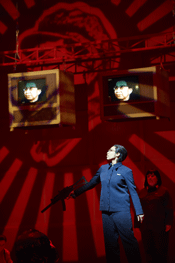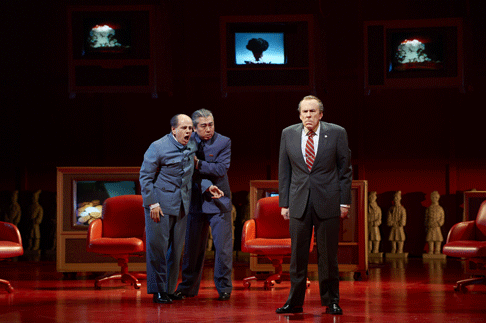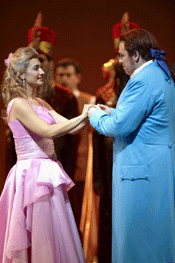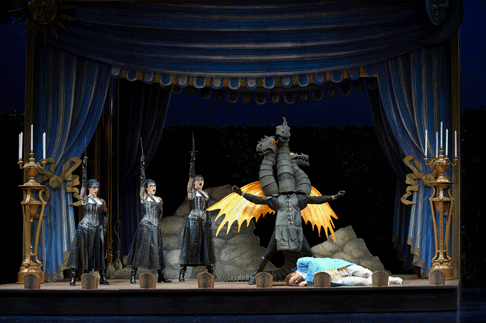15 Feb 2011
The Chill of Grace: A Winter Weekend at COC
At the moment, it seems inevitable that John Adams’ 1987 opera Nixon in China will become a fixture in the repertoire.

At the moment, it seems inevitable that John Adams’ 1987 opera Nixon in China will become a fixture in the repertoire.
James Robinson’s stylish and imaginative production from 2004, revived this season by the Canadian Opera Company, illustrates that this opera indeed has a life beyond that imagined by its creators. In fact, viewing Robinson’s Nixon in quick succession with creator Peter Sellars’ recent restaging at the Metropolitan Opera confirms the impression from 2004 that this opera will provide inspiration for creative teams for generations to come. In the instance of Robinson’s production (originally designed for Opera Theatre of Saint Louis), the integrative video design revolutionizes the use of projections within opera by timing visual sequences so intimately with the music that the result is practically a new visual libretto. The chosen images are astute as well as visually stunning, as in the top of Act II when static on the television screens created a snowy landscape. The televisions themselves were used as modular architecture throughout the opera; descending from the sky en mass, acting as a dais for speeches, and evoking individual spaces (perhaps even headboards) for each of the characters during Act III.
 Marisol Montalvo as Chiang Ch’ing (Madam Mao) (front) and Megan Latham as Third Secretary to Mao (behind)
Marisol Montalvo as Chiang Ch’ing (Madam Mao) (front) and Megan Latham as Third Secretary to Mao (behind)
Robinson, his design team, and the cast have struck a fine balance that
divides the story-telling between the live action onstage and the use of video
while simultaneously blurring the distinctions between the two elements. At
times, the characters strike poses as if captured within a snapshot and these
moments of heightened realism integrate beautiful with the meta-commentary both
on the screens and built into Adams’ score. Furthermore, despite the
inherent challenge of portraying historical figures, the majority of the cast
does an excellent job of breathing inner life into what could become
caricatures. Robert Orth could scarcely act the role of Nixon better, but he
could have afforded to sing with more beauty of tone at least some of the time.
In particular, the moment when Nixon speaks of fathers and sons joining hands
in peace would have been even more effective had Orth sung more like a baritone
and less like a president. As the Chinese Prime Minister Chou En-lai, Chen-Ye
Yuan was quietly compelling from the very beginning through the opera’s
haunting last line.
Like the real Henry Kissinger, Thomas Hammons was a strange mixture of enigmatic power and allure. He also seemed to embrace his role as Lao Szu within the ballet with real gusto. Maria Kanyova found both the lyrical and coquettish moments as Pat Nixon and her diction was impressive throughout. Her middle voice could be more attractive, but her floated top notes were so easily suspended that it seemed a shame for conductor Pablo Heras-Casado to rush through them. As Mao Tse-tung and his wife Chiang Ch’ing, Adrian Thompson and Marisol Montalvo were both committed dramatically but lacked the vocal goods to back up what could have been splendid performances.
 Adrian Thompson as Mao Tse-tung, Chen Ye-Yuan as Chou En-lai and Robert Orth as Richard Nixon
Adrian Thompson as Mao Tse-tung, Chen Ye-Yuan as Chou En-lai and Robert Orth as Richard Nixon
Even though most of the action onstage was well synchronized with Adam’s music, there were several moments of dynamic imbalance between the orchestra and the singers that cannot be attributed to the use of amplification in Adam’s score. Rather, the orchestra was plagued by imprecise playing and pacing throughout, which became distracting and detracted from Adam’s astute choices of orchestration. That said, the chorus was impeccably rehearsed by Sandra Horst and it seems very likely that some of the musical missteps will be corrected during the course of the run.
The lighting by Paul Palazzo was some of the most effective work I have ever seen in any theatre — ranging from the eerie glow of an unseen television flickering on the faces of the typical American family to use of Chinese lanterns on the television screens as a light source. Allen Moyer’s set design provided several layers of visual and semiotic interest, especially for Pat Nixon’s tour of sites during Act II, and James Schuette’s costumes were rhetorically effective while maintaining a strong sense of the opera’s place and time.
 Isabel Bayrakdarian as Pamina and Michael Schade as Tamino
Isabel Bayrakdarian as Pamina and Michael Schade as Tamino
Ultimately, the success of Saturday evening’s performance was largely due to
Robinson’s creative staging which faced the challenges of the libretto
while allowing the quality of the music to speak for itself. In this respect,
Diane Paulus’ new production of Mozart’s Die Zauberflöte was an
entirely fitting companion piece for Nixon in China. Paulus reimagined
the opera’s action taking place on the grounds of a beautiful 18th
century estate as an entertainment on the occasion of the name day of Pamina.
The resulting play-within-a-play scenario worked incredibly well for the first
half of the opera. The staging of the overture introduced the new framework of
Mozart’s familiar characters with uncanny clarity. Papageno took charge
of last-minute rehearsals with some of the estate’s ruder mechanicals
while Sarastro, as lord of the manor, oversaw the entire operation.
From the moment the curtain went up, the cast embraced their dual roles as characters within the festivities and their “real life” counterparts. Betty Waynne Allison, Wallis Giunta, and Lauren Segal were as strong individually as they were as a trio. Rather than portraying Tamino as a bland hero, tenor Michael Schade embraced the ambiguity of his role. He sang and acted like a lover and prince (even to the point of being overly precious vocally) but occasionally revealed a more human impatience or even harshness. Rodion Pogossov and Lisa DiMaria were ideally matched as Papageno and Papagena. They were both as generous with their vocalism and musicality as they were with their spirited comedic performances. Isabel Bayrakdarian may not have been ideally cast as Pamina, but her acting had the strength of purpose and conviction necessary to turn the role into the opera’s true heroine. As her mother, Aline Kutan delivered a one-two punch with the Queen of the Night’s arias that won’t soon be forgotten.
 Lauren Segal as the Third Lady, Wallis Giunta as the Second Lady, Betty Waynne Allison as the First Lady and Michael Schade as Tamino (lying down)
Lauren Segal as the Third Lady, Wallis Giunta as the Second Lady, Betty Waynne Allison as the First Lady and Michael Schade as Tamino (lying down)
House Music Director Johannes Debus led the orchestra in a brisk and lively performance. With the exception of a slightly scrappy final chorus, the choristers were as excellent as they had been the night before. Furthermore, Paulus’ new context for the opera finally allowed for a female chorus contingent that didn’t seem totally superfluous to the action. The production’s concept was not as fully realized in the second half, but the significant strengths of Act I and the pure charm throughout (enhanced at every turn by set and costume designer Myung Hee Cho) made the production a joy to behold.
As for the Canadian Opera Company itself, to paraphrase Alice Goodman’s excellent, beguiling libretto for Nixon in China, how much of what they did last weekend was good? Most of it was good, and some of it was even great.
Alison Moritz